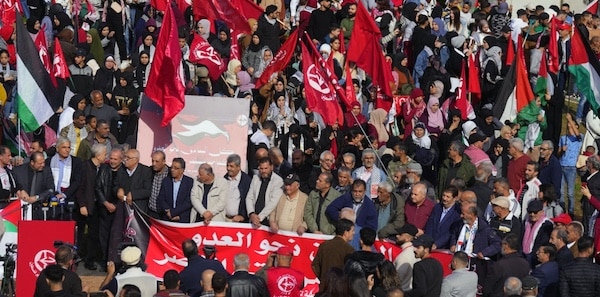THE danger signals of a wider war breaking out in the Middle East are now flashing red.
If the most compelling reason for securing a stable and permanent ceasefire in Gaza remains the indescribable suffering of the Palestinian people under merciless Israeli assault, then this danger constitutes a barely less important second one.
There is a major flashpoint on the Israeli-Lebanon border, where Israeli armed forces and Hezbollah have been exchanging fire on a regular basis since the start of the present Gaza crisis. Hezbollah is both a part of the Lebanese government and a major armed force in its own right.
As a result of these clashes, the Israeli authorities have evacuated several residential areas near the border. On Tuesday, Israel’s defence minister renewed threats to act to eliminate Hezbollah.
This is something Israel has attempted without success in the past. The Lebanese organisation is a formidable military opponent. Today, however, Israel is supported by two U.S. aircraft carrier groups dispatched to the eastern Mediterranean by the Biden administration.
Hezbollah enjoys the strong support of Iran, so it is not impossible that the Islamic Republic could be drawn into any escalating confrontation. The people of Lebanon would certainly be among the major victims of such a clash.
In a separate but connected development, major shipping firms have suspended transit through the Red Sea and the Suez Canal on account of missile attacks on vessels by the Houthi forces in Yemen. This will have a major disruptive impact on the world economy if it persists.
The Houthis, who have been fighting both a civil war and a war against Western-backed intervention by Saudi Arabia and the United Arab Emirates for years, say they are targeting any ships carrying supplies to Israel.
The U.S. and other Western powers are now deploying a vast array of naval and military assets in the area and there is speculation they may strike directly against the Houthis. The British navy is heavily involved.
It is claimed that the Houthis are aligned with Iran, too, although the evidence is sketchy. The movement’s indigenous roots in Yemen are beyond doubt. However, trigger-happy elements in Israel and the U.S. have been itching for any excuse to target Iran for years now.
Nor is it self-evident that war with Iran would remain confined to Iran only, since it is increasingly aligned with Russia.
So there are two clear and distinct roads leading to a widening conflict.
Both have their immediate starting point in the assault on Gaza. The massacre of Palestinians has been the trigger for both the heightened tension on the Israel-Lebanon border and the actions of the Houthis.
A first step in de-escalation is an immediate and permanent ceasefire in Gaza to stop the horrifying loss of Palestinian lives and to allow urgent humanitarian aid to reach the people of the besieged enclave.
That could create the conditions for both clashes to stop. There is certainly no solution to be found in renewed U.S. or British military action.
It is their interventions over the last century and more that have in large part made the Middle East the seat of so many debilitating conflicts.
So de-escalation starts with a cessation of hostilities in Gaza. It must then proceed to a lasting settlement ending the oppression of the Palestinians alongside the withdrawal of imperialism and its militaries from the region, allowing states to build their own relations and peoples to chart their own future free of dictation by Washington and London.
The anti-war movement must mobilise behind this perspective as never before. The situation could not be more urgent.

